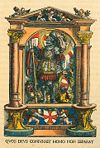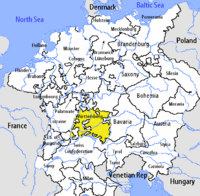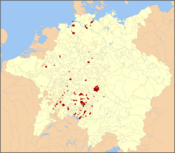Bad Wimpfen
| Bad Wimpfen | |
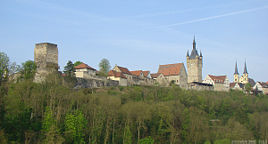 |
|
| Coat of arms | Location |
 |
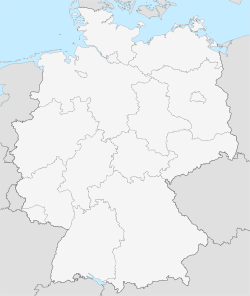 |
| Administration | |
| Country | Germany |
|---|---|
| State | Baden-Württemberg |
| Admin. region | Stuttgart |
| District | Heilbronn |
| Town subdivisions | 3 |
| Mayor | Claus Brechter |
| Basic statistics | |
| Area | 19.38 km² (7.5 sq mi) |
| Elevation | 195 m (640 ft) |
| Population | 6,911 (30/12/2006) |
| - Density | 357 /km² (924 /sq mi) |
| Other information | |
| Time zone | CET/CEST (UTC+1/+2) |
| Licence plate | HN |
| Postal code | 74206 |
| Area code | 07063 |
| Website | www.badwimpfen.de |
| Location of the town of Bad Wimpfen within Heilbronn district | |
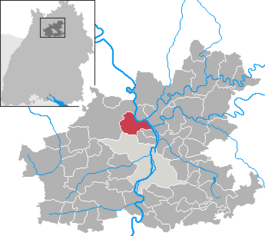 |
|
Bad Wimpfen is a historic spa town in the district of Heilbronn in Baden-Württemberg in southern Germany. It lies north of the city Heilbronn, on the river Neckar.
Contents |
Geography
Bad Wimpfen is situated on the left Neckar bank around 15 km in the north of Heilbronn. The town is divided in two parts: The older Wimpfen im Tal (Lower Wimpfen) situated at the Neckar and Wimpfen am Berg (Upper Wimpfen) containing the town centre. Besides of the town itself the village Hohenstadt also belongs to Bad Wimpfen.
Neighbouring municipalities
Neighbouring town and municipalities of Bad Wimpfen are (clockwise from the south): Heilbronn, Bad Rappenau, Offenau, Bad Friedrichshall, Untereisesheim and Neckarsulm.
History
First settlement by the Celts
First traces of settlement on the communal land of Bad Wimpfen are proved at the Neolithic and the Bronze Age. An old trade road running from France forks here towards Nürnberg and Öhringen resp. the Danube. It has already been used in prehistorical times proved by several finds.
Around 450 B.C. the Celtic tribe of the Helvetii settled at the Neckar, Kocher and Jagst around Bad Wimpfen. Presumably the Celts had been given names to the rivers as they are today. Wimpfen presumably comes from "uimpe" (umwallt) = "surrounded" and "bin" (Berg) = "mountain".
Roman time
Presumably in 98 A.D. the Romans secured the area in south-western Germany conquered by Domitian (called the Dekumatland) by the Neckar-Odenwald-Limes, a system of castella built every 12-15 kilometres. In opposite to the Jagst mouth the castellum Wimpfen im Tal has been created. Like other places, a civil settlement formed around the castellum containing many traders and manual workers.
After the expansion of the Roman Empire up to the Limes near Jagsthausen arranged by emperor Antonius Pius in 138-161 A.D. the castellum lost its military importance.
All the more important was Wimpfen im Tal as a civil town. It has been the centre of a district called Civitas Alisinensium and was surrounded by a city wall like just a few Roman towns in today's southern Germany. The surface has been about 19 hectare being one of the biggest Roman towns in today's Baden-Württemberg. Despite this importance the Latin name of the town is unknown today.
Besides there has been a wooden bridge above the Neckar getting destroyed by severe ice occurrence in early Middle Ages. The origin of a beam salvaged during excavator works in 1957 is proved to be a part of the old bridge. A survey proved a year around 85 A.D.
Development until Middle Ages
After the withdrawal of the Romans the Alamanni governed the Neckar area since 260 A.D. During this time the most Roman buildings dilapidated, since the Alamanni didn't know anything about stone building and how to use Roman infrastructure. Around 500 Wimpfen came to Franconia. By the settlement of the Franks according to Clovis I Christianity has been bloomed, so the today's oldest Christian buildings originate from this time.
In the 9th century Wimpfen came to the Bishopric of Worms and was first mentioned documentary as Wimpina in 829. In this time the Hungarians attacked the region and devastated the most settlements including Wimpfen. Within the framework of the following reconstruction the new diocese church St. Peter was built. Being a bigger building, it was dedicated to the patron of the Bishopric of Worms. During more than three centuries the local dioceses had been performed the jurisdiction there.
Market right and Staufer


By a document of King Otto I Wimpfen got market rights in 965. By the good transport situation and the local jurisdiction the market developed splendidly. The Wimpfen's Talmarkt (valley market) has a history of more than 1000 years and is one of the most traditional market events in Germany.
In 1182 a stay of Friedrich Barbarossa is presumed there. His empire has been administrated decentrally. The Staufers had built Kaiserpfalzen at many places. They were big castles where emperors stayed and jurisdicted. The Pfalz Wimpfen was built on a mountain above the settlement of the Neckar valley. The Pfalz and its surrounding settlement grew so strong that soon the older settlement at the Neckar bank got less important. Around 1200 the most buildings of the Staufers had been built, including the symbol of the town called Blauer Turm (Blue Tower). It served as a watch-tower until the 20th century.
The Stauferpfalz of Wimpfen is the biggest preserved one in the north of the Alps. Its length was about 215m, its width about 88m. Emperor Henry VI has been stayed there at least three times, Friedrich II. eight times. In 1235 there was a historical meeting between Friedrich II. and his rebellious son. Also in the 13th century Richard von Deidesheim arranged a rebuilding of the diocese church into the Gothic style. At the same time a hospital and a Dominican's monastery had been founded.
Due to the decline of the Staufers Empire Wimpfen became a Reichsstadt, so many manual workers settled down and a big citizenery established. The citinzenery arranged a town constitution, getting an example to many other towns. There are many today's buildings originating from this time.
Emperor Friedrich III. gave the right to hold a second market except the established Talmarkt called the Katharinenmarkt. This tradition is alive until today, too, and its fame runs up to the whole country of Baden-Württemberg.
Times of Reformation
In the 16th century Wimpfen has been a stronghold of Reformation. Probably the most important reformator was Erhard Schnepf being a preacher from 1523 to 1526. His contemporary Heinrich Vogtherr created many reforming writings and songs. Although the Catholics offered huge resistance to Reformation, their amount decreased more and more. In 1588 there were just 30 Catholic inhabitants. Catholics lost their civil rights and their churches came to the Protestant parish.
Thirty Years' War

This religious conflict soon got less important, since troops of imperial Johann Tserclaes fought against the army of Margrave Georg Friedrich in 1622 nearby the town. This Battle of Wimpfen has been one of the most important and bloody ones during Thirty Years' War.
As things developed Wimpfen got looted several times, houses and fields burned down. The population decreased heavily by diseases and epidemics. At the end of war in 1648, the population has been reduced onto a tenth of the amount in prewar days. Many great buildings were destroyed, and to redevelop existing buildings big parts of the castle had been taken down.
The town had to suffer by devastating consequences of Thirty Years' War for more than 150 years. Although the Celts already had extracted salt in pre-Christian times, there was no possibility to produce salt in brines now. There was still huge poverty within the population. During this time the town got financial aid by the Reichsstadt Nürnberg.
|
|||||||||||||||||||||||||
In 1783 the wood of surrounding forests was to be chargeable to the population to increase the town's financial situation. However, the citizens also weren't able to afford these fees. In consequence there were many riots getting suppressed by orders at the end.
In the first time, by the Reichsdeputationshauptschluss the town came to Baden. However, the knightly diocese of Wimpfen im Tal came to Hesse-Darmstadt. In consequence a conflict about sovereignty rights of the diocese increased between Baden and Hesse. Finally Baden was willing to manage an interchange of area since the own territory was far away - so Wimpfen came to Hesse. This chance has been proclaimed on April 5th, 1803. Since 1805/06 Wimpfen has been an exclave of Hesse.
This was a very comfortable situation to the town being able to administrate itself autonomously. By the foundation of People's State of Hesse in 1919 Wimpfen became part of the district of Heppenheim. Getting fusioned with the district of Bensheim in 1938 it arose to the Kreis Bergstraße. After all, Wimpfen belonged to Hesse for 140 years. In 1945 the American military government changed this situation and Bad Wimpfen came to Baden.
Brining and bathing
In 1817 there was the first success in salt-mining. Except from technical service in times of industrialisation the brine was able to be used therapeuticly; in 1835 the first cure hotel opened. A sign of new economic prosperity also is the new town hall built in 1836. Despite many buildings of the Staufers got knocked down or stayed out of use.
After opening the new rail road running from Heilbronn to Heidelberg in the 1860s, the cure business increased heavily. Baths got expanded more and more resulting in an economic flourishment. Even Mark Twain reported about this fact by accounts of his journey through Europe in 1867. On April 26th, 1930, the town got its prefix Bad officially.
World War II has been survived almost undamaged, so many refugees arrived here to take accommodation.
Between Hesse and Baden-Württemberg
On September 19th, 1945, the American military government proclaimed the foundation of Greater Hesse and Württemberg-Baden. Now the exclave was completely surrounded by Württemberg-Baden, namely by the districts of Sinsheim and Heilbronn belonging to Baden resp. Württemberg. On November 26th the occupying power decided to have the district of Sinsheim administrate the town. As things developed the town got a part of Württemberg-Baden legally, being confirmed by the OLG Stuttgart on March 6th, 1951.
Within the population this decision caused ill-humour, even Hesse itself demanded a return of its enclave. In a plebiscite of April 29th, 1951, just 0.7% of the inhabitants voted to stay in the district of Sinsheim. Around 41% voted to return to Hesse, but a mayority of 57% decided to change into the district of Heilbronn. This has been carried out on May 1st, 1952.
Despite this result Hesse insisted its opinion of Bad Wimpfen being a Hessian town. However, it agreed in an administration by meanwhile founded Baden-Württemberg. This means that the final status of affiliation isn't clear until today. However, Bad Wimpfen is completely integrated into the administration and jurisdiction of Baden-Württemberg.
By its Hessian past the Catholic church still belongs as an exclave to the Diocese of Mainz.
Present
In present Bad Wimpfen impresses both by its cure institutions and its valuable existence of building momuments. The historical old part of the town is protected completely. Since 1976 a comprehensive program of redevelopment resulted in an important revaluation of the most buildings. Due to the recession of the 1990s further redevelopments go back to private initiatives.
Religions
Except from a Protestant and Catholic parish in Bad Wimpfen is the New Apostolic Church and Jehovah's Witnesses. Inside the diocese church St. Peter has been housed Grüssau Abbey from 1947 to 2006. The unique Saint Benedict monastery in the district of Heilbronn containing three monks in 2005 broke up in autumn of 2006. Now these monks are living in Neuburg Abbey near Heidelberg, Sigmaringen, Kellenried Abbey and Pannonhalma Archabbey.
Formerly there also was a Jewish parish. An early mentioned Jew who lived in Wimpfen was Alexander ben Salomo who released the remains of Rabbi Meir of Rothenburg. Both are buried in Worms. Jews are proved in the 14th, 15th and 16th century. Around 1550 there was a short-term expulsion. Since the 17th century Jews are proved well, temporary they lived in five houses. There were several Jew orders in 1598, 1630, 1756 and 1762 discriminating them in usual ways. In 1672 there was an expulsion canceled two years later. After times of imperial towns Jews had been equated. In 1933 there lived 22 Jews in Bad Wimpfen getting discriminated more and more. In 1938 there were riots against Jews, their shops and houses. Until summer of 1941 most Jews were allowed to emigrate. There were at least four Jewish deaths by persecution.
Politics
District council
Following the municipal election of 13 June 2004, the district council of Bad Wimpfen has 17 seats. The election result is as follows:
| party | amount | +/- | seats | +/- |
| CDU / FW | 49.6% | (+4.8) | 9 | (+1) |
| SPD | 24.8% | (−0.8) | 3 | (−1) |
| FDP / DVP / Unabhängige Bürger (UB) | 16.6% | (+2.0) | 3 | (+1) |
| GRÜNE / Offene Liste (GOL) | 11.4% | (+4.4) | 2 | (+1) |
| Others | 0.0% | (−10.4) | 0 | (−2) |
The mayor is also a member of the district council and its chairman.
Arms and flag

Blazon: In gold the red Eagle of Empire with a horizontal silver key in its beak. The town colours are red, white and blue.
The weapon figures of Eagle and key already appeared in Wimpfen's seal of 1250, used until 1436. The eagle has been a former symbol of Wimpfen's dependency on the empire in time of Staufer. Since the 14th century it was the symbol of the free imperial city. The key is both the emblem of Saint Peter and the weapon figure of the Bishopric of Worms. It reminds that the castle has been built on communal land of Worms. As things developed the key position changed a bit several times. There were mostly the colours black (eagle) and gold (sign).
In times of Hessian membership temporary the town had another arms. However, this has been cancelled after changing to Baden.[1]
Twin towns
Since 1967 there's a relationship with Servian in the French Département Hérault. In 1951 Bad Wimpfen took godparenthood to Ödenburg (today's Sopron) in Hungary and so offered a new native town to many exiles after World War II.
Culture and sights


Notable buildings
Kaiserpfalz
The most important monument of Bad Wimpfen is the Kaiserpfalz. Its symbol is the Blauer Turm (Blue Tower) where an attendant lives for 650 years. Even the tower can be visited. The Roter Turm (Red Tower) is a second tower of the Pfalz.
Church monuments

The Protestant Stadtkirche was built in the 13th century in Romanesque architecture and ended in Gothic architecture. Next to the church there's the calvary.
The construction of the Dominikanerkirche presumably started in the 13th and ended in the 18th century. The former monastery with artistic cloister contents a school today. The church is used as the Catholic parish church.
The former Johanneskirche was built in the 15th century and rebuilt in 1778. It got secularizated in 1803. By a fire in 1851 the church lost its function, since then the building served as a restaurant.
In the castle quarter there's the former Jewish praying house of 1580.
The diocese church St. Peter in Wimpfen im Tal, set of Grüssau Abbey from 1947 to 2004, presumably goes back to the 7th century. The today's church with bordering cloister has been built in the 13th and 14th century; there was a comprehensive renovation until 2006.
The Cornelienkirche is bordering in the east of the middle of Wimpfen im Tal. The building built in 1476 in Gothic style has a splendid portal with wall drawings. Presumably inside this church there has been the camp of Tilly during the Battle of Wimpfen.
Besides the village Hohenstadt contents an old Protestant parish church.
Secular monuments
- The Bürgerspital (donated around 1230) is one of the oldest timberings of the town. Since 1992 it contains the imperial town's museum.
- The Wormser Hof is situated next to the Kaiserpfalz nearby the town hall. The borderline behind represents a part of the city wall.
- The residential building Am Marktplatz 6 was built in 1266 and has been one of the oldest timberings in Baden-Württemberg.
- The Bürgermeister-Elsässer-Haus was built underneath the Blauer Turm in 1717.
- The Nürnberger Türmchen next to the Red Tower was erected in gratitude to the city of Nuremberg for its help in the reconstruction of the heavily damaged city walls after the Thirty Years War.
- Inside the whole old part of the town there are many timberings of the 16th century.
Springs
Museums
There are several museums inside the historical old part of the town.
Theatre
Since 2003 the Wimpfen open-air shows open-air plays in front of the historical old scenery of the town.
Sports and leisure
In Wimpfen there's a brine bath and an open-air pool. The most successful sports club is the row club of the town.
Regular events
In Bad Wimpfen there's the Talmarkt taking place since 965. Besides there's the Christmas market also being very traditional.
Economy and infrastructure

One of the biggest employers in Bad Wimpfen is Solvay Fluor GmbH containing more than 350 employees and producing different products in Fluorine chemistry, e. g. refrigerants and propellants.
Traffic
Bad Wimpfen is situated at the rail road Elsenztalbahn running from Heilbronn to Heidelberg and is nearby the A 6 (junction Heilbronn/Untereisesheim).
Media
About happenings in Bad Friedrichshall the Heilbronner Stimme (edition north-middle) and the official paper Wimpfener Heimat-Bote are reporting.
Education
In Bad Wimpfen there's a primary school, Hauptschule incl. Werkreakschule containing around 380 pupils. Besides there's the Hohenstaufen-Gymnasium having more than 900 students of Bad Wimpfen and its surrounding municipalities.
Health
The urban health centre of Bad Wimpfen (former cure hospital) cares about 4800 patients by a staff of 200 persons.
References
- ↑ Heinz Bardua: Die Kreis- und Gemeindewappen im Regierungsbezirk Stuttgart. Theiss, Stuttgart 1987, ISBN 3-8062-0801-8 (Kreis- und Gemeindewappen in Baden-Württemberg, 1). p. 42
Eberhard Gönner: Wappenbuch des Stadt- und des Landkreises Heilbronn mit einer Territorialgeschichte dieses Raumes. Archive direction Stuttgart, Stuttgart 1965 (Publication of the national archive administration of Baden-Württemberg, 9). p. 154ff.
Literature
- Ludwig Frohnhäuser: Geschichte der Reichsstadt Wimpfen, des Ritterstifts St. Peter zu Wimpfen im Thal, des Dominicanerklosters und des Hospitals zum hl. Geist zu Wimpfen am Berg. Darmstadt 1870, Nachdruck Verein Alt Wimpfen 1982.
- A. von Lorent: Wimpfen am Neckar - geschichtlich und topographisch. Stuttgart 1870, Nachdruck Verein Alt Wimpfen 1982.
- Georg Schäfer: Kunstdenkmäler im Großherzogthum Hessen, Provinz Starkenburg. ehemaliger Kreis Wimpfen. Darmstadt 1898.
- Fritz Arens, Reinhold Bührlen: Wimpfen – Geschichte und Kunstdenkmäler. Bad Wimpfen (Verein Alt Wimpfen) 1954, 1991.
- Rüdiger Jülch: Die Entwicklung des Wirtschaftsplatzes Wimpfen bis zum Ausgang des Mittelalters. W. Kohlhammer, Stuttgart 1961.
- Walter Carlé: Die Geschichte der Salinen zu Wimpfen. Stuttgart (Zeitschrift für Württembergische Landesgeschichte XXIV) 1965
- Albrecht Endriss: Die religiös-kirchlichen Verhältnisse in der Reichsstadt Wimpfen vor der Reformation. Stuttgart (W. Kohlhammer)1967.
- Klaus-Peter Schroeder: Wimpfen. Verfassungsgeschichte einer Stadt. W. Kohlhammer Verlag, Stuttgart 1973.
- Andreas Hafer: Wimpfen. Stadt-Raum-Beziehungen im späten Mittelalter. Stuttgart (W. Kohlhammer) 1993.
- Franz Götzfried (Hrsg.): Salz und Sole in Wimpfen. Beiträge zur Wimpfener Stadt- und Salinengeschichte. Bad Wimpfen 2002.
- Erich Scheible: Die Geschichte der hessischen Exklave Wimpfen. Bd. 1: 1802 bis 1836. Bad Wimpfen (Verein Alt Wimpfen) 2004.
External links
- http://www.badwimpfen.de The official website of Bad Wimpfen (in German)
- Bad Wimpfen at the Open Directory Project
- Das Rathaus im Weinbrenner-Stil auf badischewanderungen.de
|
|||||||||||||
|
|||||||||||||||||||
|
||||||||||||||||||||||||
|
|||||||
